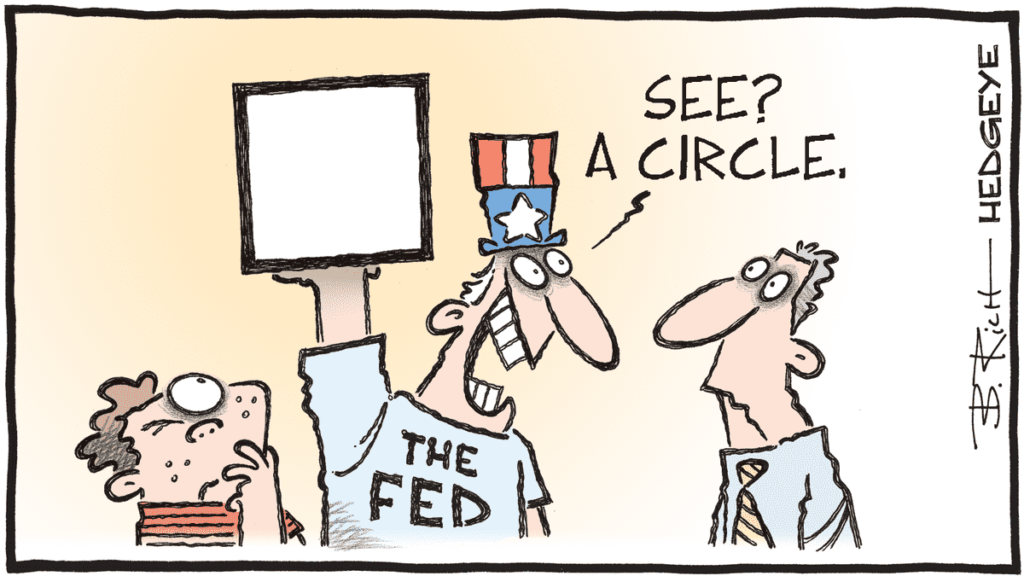
After Monday’s panic, we experienced the calm of Tuesday. Most global indices ended higher after the postponement of Trump-era tariffs. That was the main takeaway. It was also notable that China’s retaliatory tariffs did not faze U.S. markets. Given the ultra-quick resolutions found for Mexico and Canada, the financial world now expects equally swift solutions with China. A phone conference between Xi and Trump is even anticipated any day now.
Beyond that, it’s all about earnings reports.
The Waltz of Volatility
I must say, I’m impressed by one thing: our ability to panic on Monday, send volatility soaring while making anxious calculations about the future of consumption and inflation—only to bounce back 24 hours later with such impressive serenity that you’d think the unemployment rate was at 2%, the Fed had just cut rates to 2.5%, and Powell himself had announced it dressed as a dove to make things more relaxing. And all because 10,000 soldiers and a hefty billion dollars are supposedly going to stop drug trafficking in the North and South of the United States—well, mostly fentanyl, because cocaine has long been part of the culture. In just 24 hours, we’ve gone from tears to laughter, and nobody seems surprised. And on top of that, it’s the second week in a row we’ve been given the same performance.
Volatility is back around 17%, and now we’re just waiting to see how Trump is going to handle his issues with China. But one thing seems firmly embedded in traders’ minds: everything’s going to be fine. Well, we still have a couple of problems, especially since the AI stock market darling, Nvidia, is struggling to recover from the DeepSeek affair, and its chart looks pretty ugly. You can feel that AI is starting to lose a bit of its magic as a market argument. It still works, but a little less. Even though Palantir was one of yesterday’s big winners, largely emphasizing AI in their quarterly reports, investors are becoming more cautious and selective on the topic. Nvidia remains a major issue, even if everyone wants to buy it on weakness. The real question is: when will strength return?
The Tariffs
In any case, if we had to sum up yesterday’s session, we could simply say that we’re back to “business as usual,” calmly digesting the tariff issue—just as we had “calmly” digested DeepSeek last week. Yesterday, the S&P 500 closed above 6,000 points—6,037 to be precise—and we’re now just 91 points away from a new all-time high. The broad U.S. index has just taken a direct hit from:
- The questioning of its dominance in artificial intelligence
- The tariff issue, which could drive inflation up and hurt consumers
- The realization that, in this environment, the Fed is nowhere near cutting rates. We’re not yet talking about a hike to curb inflation, but let’s keep that option open for spring.
And yet, despite these developments, which hardly qualify as “fantastic news that makes me want to sell my children to buy the market,” we are just a stone’s throw away from record highs. This applies to the Dow Jones, the Nasdaq, and the DAX. The only real laggard is the SOX, which seems stuck in its sideways channel, waiting for a breakout—up or down. Given AMD’s earnings report last night, we might start to think we’re heading lower.
Quarterly Figures
In the midst of these markets that now present a completely different face than they did on Monday morning, we have to acknowledge that there’s an avalanche of news to process all at once. And yet, we always refer to “THE MARKET.” A market—meaning it’s masculine, and if I’m not mistaken, men aren’t exactly known for their ability to multitask… except when it comes to the buttons on a PlayStation or Xbox controller, of course. So, let’s admit it: these are long and complicated days, juggling Trump’s omnipresent communications—he seems to have a gift for being everywhere at once on every topic—while weighing their economic, political, and inflationary consequences. And on top of that, we have to seamlessly navigate the flood of quarterly earnings reports that are saturating the media right now, making it feel like a small northern French village experiencing its eighth flood of the year.
Since this morning’s market action is all about waiting for Xi Jinping’s call to Trump and interpreting quarterly results, let’s take a moment to review the latest earnings releases from the past 24 hours—just to see how the market is reacting. Because, let’s be honest, today we can classify the interpretation of quarterly figures into four main categories, each leading to its own predictable outcome.
-
The first category includes companies that have exceeded expectations across the board, except for one single metric that falls short. Naturally, the market fixates on this one flaw and sells the stock massively, repeatedly asking, “How could they mess that up?!” This quarter, Microsoft falls into this category.
-
The second category consists of companies that have crushed expectations so impressively that analysts don’t even understand their business model. In these cases, traders rely on the CEO or CFO’s earnings call to decide whether to buy or sell like mad. A little tip: if you don’t understand the business plan and management drops the term artificial intelligence in their speech, you should buy aggressively. This quarter, that’s exactly what happened with Palantir.
-
The third category covers companies that, three months ago, confidently announced they were on fire, their future looked brighter than ever, and that things were only going to get better. Fast forward to today, and they report mediocre results while admitting they’re now flying blind in a fog so thick they don’t even know if they’re upside down or not. Naturally, this kind of result triggers selling. This quarter, AMD and Julius Baer fit the bill.
-
The fourth category consists of companies that get everything right: they beat expectations across the board, dominate their industry, manage costs with surgical precision, see a rosy future, and even buy back their own shares as if money were no object. Ironically, these stocks tend to get crushed immediately—because, you know, “you have to take profits at some point.” Yesterday, that was the case with UBS.
Let’s take a quick look at some of the earnings released yesterday, skipping over the raw numbers and focusing on market perception. Because, between you and me, what’s the point of holding a company in your portfolio that looks perfect on paper but is hated by the market? The real question isn’t about the quality of the figures—it’s about understanding what Mister Market decides to do with them.
Yesterday’s and Last Night’s Numbers
Let’s start with Dassault Systèmes, which outperformed expectations and saw its stock soar primarily because they announced a project in artificial intelligence. This is the perfect example: when you read the press release, you don’t understand a word, but as long as it’s AI-related, it must be good. The stock jumped nearly 9%. It was basically the French version of Palantir yesterday.
Then there was Pepsi, which beat profit expectations but reported a 0.2% revenue decline. That was a disappointment, and the stock dropped 4.5%.
Spotify had its own “Netflix moment”, as it announced better-than-expected subscriber numbers. Nobody cares about revenue or profit—as long as subscriber numbers go up. Spotify soared 13%.
Merck, on the other hand, took a 9.1% nosedive despite reporting better-than-expected earnings. Why? Because its forward guidance wasn’t as strong as analysts had hoped. See? Even when you beat estimates, if you’re navigating through uncertainty and fog, things get tricky.
Yesterday afternoon also brought us conspiracy theorists’ favorite earnings report: Pfizer. The pharmaceutical giant posted a 63 cents per share profit, significantly beating the 46 cents expected by Wall Street analysts. They also reaffirmed their guidance. Yet, the stock fell 1.3% because, unfortunately for them, the Senate is confirming Robert Kennedy as Health Minister, and everyone knows he’ll be out for blood when it comes to Big Pharma.
More Earnings Reports
Last night after the market closed, we got results from AMD, Google, Chipotle, and Amgen. There were others, but if I covered them all, I’d be publishing this analysis at 8 PM tonight—and by then, it wouldn’t be relevant anymore.
AMD beat expectations, but not by enough to blow anyone away. Before the announcement, the stock was up 5%, and everything seemed fine. Then AMD reaffirmed its forward guidance—so far, so good. But then they dropped a bombshell by announcing they would no longer provide revenue forecasts for their AI chip segment.
Big mistake. Huge mistake.
The stock plunged 10%, wiping out 15% from its intra-day high to its after-hours low—the equivalent of $30 billion in market cap gone in 15 minutes. When you have a product that’s supposed to generate mountains of revenue—like Nvidia’s magical Blackwell chip—you want to hype it up. But when you suddenly refuse to provide revenue projections, it screams red flags. Investors are now wondering what AMD is hiding.
Next up was Google. They also beat expectations but disappointed in their Cloud segment, just like Microsoft. No surprise there: the stock dropped 7% after-hours. Some analysts also pointed out that Google/Alphabet announced AI-related expenses exceeding market expectations.
The funny thing? When Meta announces higher AI spending, investors love it. But when Google does it, they panic. Clearly, not all tech giants are created equal, and it seems Zuckerberg is more equal than the others.
Chipotle posted solid numbers but reported weaker-than-expected revenue growth, sending the stock down 6% after hours.
Amgen reported higher-than-expected profits, 11% revenue growth, and announced that phase-final trials for MariTide—a new weight-loss drug—will begin in Q2. This was huge news because weight-loss drugs are basically the AI of the pharmaceutical sector in terms of growth potential.
Amgen’s stock should have skyrocketed in after-hours trading. But unfortunately, they also announced that the FDA had suspended an early-stage trial of another experimental weight-loss drug.
BOOM.
The bad news canceled out the good news, and the stock went nowhere last night at 10 PM.

The Market This Morning
The Nikkei is struggling to stay positive, while Hong Kong is down 1.2%, and China, which has just returned to work, is down 0.8%. For now, the region remains fixated on the tariff discussions, and that’s about it.
Notable news: Toyota completely missed its quarter, causing its stock to drop by 4%. Additionally, there are rumors that the announced merger between Nissan and Honda may be entirely called off.
Gold: Nearing $2,900
Oil: $72.66
Bitcoin: $98,000
Other News of the Day
Donald Trump has expressed his desire to take control of the Gaza Strip and develop the region. He also suggested that Palestinians should leave the area. I’m no expert, but this might be seen as good news in the long term.
Regarding yesterday’s JOLTS report, job openings came in 400,000 below expectations. Strangely, no one seems to be talking about it.
Today, several economic reports are due for release:
- U.S. Trade Balance
- Services PMI and Composite PMI in Europe
- ISM Non-Manufacturing PMI in the U.S.
- Oil Inventory Data
Earnings to Watch Today
Several major companies will report their earnings:
- Uber
- Disney
- Novo Nordisk
- Ford
- ARM
- Qualcomm
- TotalEnergies (in Europe)
We can already hear the French left protesting about dividends being paid to shareholders.
Market Trends
U.S. futures are down 0.48% – a reaction expected after disappointing results from Google and AMD in the tech sector.
For now, all eyes are on the anticipated call between Trump and Xi Jinping. No time has been announced yet, and we still don’t know if the conversation will be broadcast live on Netflix.
Until then, have a great day, and see you tomorrow at the same time and place to analyze another phase of this bipolar market’s psychology!
See you tomorrow.

